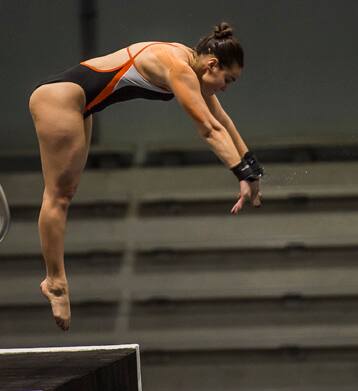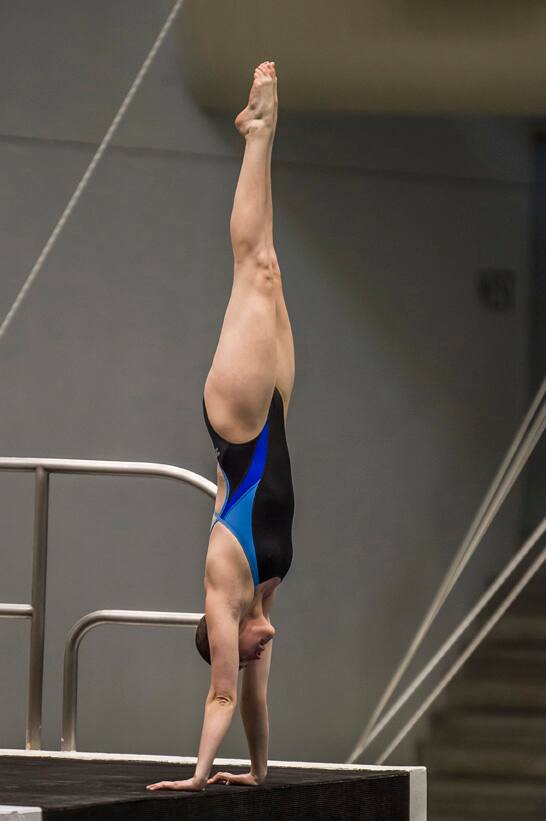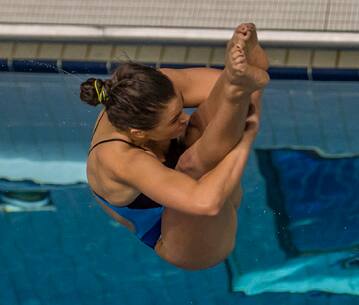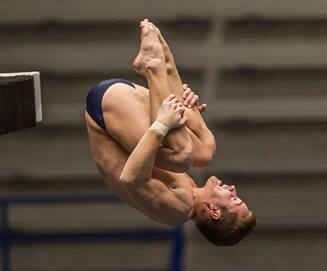DIVE GROUPS
There are six groups of dives. The first four are classified by the direction the diver rotates.
 1. Forward group: The diver faces the front of the board and rotates toward the water. Dives in this group vary from simple front dives to difficult forward, four and one half somersaults.
1. Forward group: The diver faces the front of the board and rotates toward the water. Dives in this group vary from simple front dives to difficult forward, four and one half somersaults.
2. Backward group: Dives in the backward group begin with the diver on the end of the board, with his or her back to the water, so as to rotate away from the board.
3. Reverse group: Formerly called “gainers,” these dives begin with the diver facing the front of the board but then rotates toward the board.
4. Inward group: The diver stands on the end of the board with his or her back to the water and rotates toward the board.
5. Twisting group: Any dive that uses a twist (excluding armstands) is included in this group. There are four types of twists: forward, backward, reverse, and inward.
 6. Armstand group: The diver assumes a handstand position on the edge of the platform before the dive (Armstand positions are never used on the springboard.).
6. Armstand group: The diver assumes a handstand position on the edge of the platform before the dive (Armstand positions are never used on the springboard.).
BODY POSITIONS
A dive may be performed using one of the following four positions.  Pike: The legs are straight with the body bent at the waist. Like the straight position, arm placement is dictated by the particular dive or by the choice of the diver.
Pike: The legs are straight with the body bent at the waist. Like the straight position, arm placement is dictated by the particular dive or by the choice of the diver.
 Tuck: The Body is bent at the waist and knees, with thighs drawn to the chest and heels kept close to the buttocks. Feet and knees should be kept together and toes should be pointed.
Tuck: The Body is bent at the waist and knees, with thighs drawn to the chest and heels kept close to the buttocks. Feet and knees should be kept together and toes should be pointed.
Straight: No bend at the waist or knees. Depending on the dive, there may be an arch in the back. Arm placement is the diver’s choice or is defined by the dive performed.
Free: Indicates the diver’s option to use any of the above three positions, or combinations thereof, when performing a twisting dive.
SYNCHRONIZED DIVING
In the past, synchro was common only in aquacades and diving shows. But today, synchronized diving (or synchro diving) has become one of the most popular diving events in the world. Introduced internationally at the 1995 FINA World Cup, synchro diving eventually became a full-medal Olympic sport with its debut at the 2000 Games with four events: : men’s synchro 3-meter, men’s synchro platform, women’s synchro 3-meter, and women’s synchro platform. Mixed gender synchronized is also contested at select events.
Synchro includes two divers performing the same dive from the same level board. For a platform dive, divers take off from opposite sides of the platform. For a springboard dive, divers take off from their own, adjacent boards.